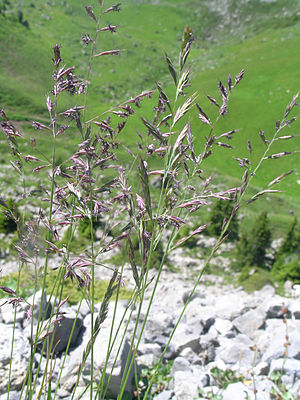Red fescue
| Red fescue i. w. S. | ||||||||||||
|---|---|---|---|---|---|---|---|---|---|---|---|---|

Red fescue ( Festuca rubra ) |
||||||||||||
| Systematics | ||||||||||||
|
||||||||||||
| Scientific name | ||||||||||||
| Festuca rubra agg. | ||||||||||||
| L. |
The term red fescue describes the very heterogeneous, richly shaped red fescue group ( Festuca rubra agg.) (= Collective species ) belonging to the sweet grasses (Poaceae ). It includes closely related clans ( taxa ) which are very similar in shape and which can be differentiated according to the time of blooming, various differences in leaf and flower characteristics, and according to their ecological preferences and their geographical distribution.
distribution
The red fescue is distributed differently across Europe , temperate Asia , North Africa and North America , depending on the clan .
description
The species in the group are perennial hemicryptophytes . They grow loosely to densely grassy or clumpy and form more or less long underground runners (rhizomes). The grasses reach heights of between 20 and 80 centimeters. The stalks grow stiffly upright. In contrast to the collective species of sheep fescue ( Festuca ovina agg.), The leaf sheaths are almost completely closed. They'll fray later. The ligule are very short and usually only formed as a narrow, membranous border. The leaf blades of the basal leaves are folded and therefore thick-bristled and stiff. No auricles are formed at the transition from the leaf sheath to the leaf blade. The stem leaves are usually flat, dull or gray-green.
The upright panicles are loose and only slightly branched. The lowest panicle branch is about half as long as the entire panicle. The spikelets reach about 10 millimeters in length. They are four to six flowered. The glumes are acuminate or briefly awned. The lemmas are awned about 1 to 2 millimeters long. The flowering period extends from April to October, but varies depending on the clan.
The characteristics vary widely within the different clans and there are numerous transitions, so that a determination is not infrequently difficult.
Small types
The list of species is based on an adaptation by E. Patzke & GH Loos and includes a complex of very similar, in part still undescribed clans.
| German name | Scientific name | Habitats |
|---|---|---|
| Horst red fescue | Festuca nigrescens Lam. | herbaceous forest clearing corridors , rocky lawns, borst grass lawns , oat valley meadows, public green spaces and facilities, wasteland and fallow land , port areas |
| Short-leaved red fescue | Festuca microphylla (St. Yves) Patzke | public green spaces and facilities, short-lived ruderal corridors |
| Flat-leaved red fescue | Festuca heteromalla Pourr. | Moist and wet meadows , subalpine storage areas |
| Hairy red fescue | Festuca trichophylla (Ducros ex Gaud) K. Richt. | Lime and pipe grass meadows |
| Salt marsh red fescue | Festuca salina Natho & Stohr | Beach carnation lawns and salt rush meadows |
| Dune red fescue | Festuca arenaria Osbeck | Beach grass dunes ( white dunes ), coastal sandschiller grass lawns |
| Common red fescue | Festuca rubra L. | Lean lawns , meadows and pastures, public green spaces and facilities, traffic routes, wasteland and fallow land |
| Rush-red fescue | Festuca unifaria Dum. | Lean lawns, step and flood turf , grassland transition areas, short-lived ruderal corridors, public green spaces and facilities, wasteland and fallow land |
use
Red fescue are high-yielding, high-quality forage grasses. All animals like to eat them. They are pasture-proof. They are also used in grass mixtures for landscaped lawns, carpet lawns, ornamental lawns, golf greens, and garden lawns.
Individual evidence
- ↑ Henning Haeupler , Thomas Muer: picture atlas of the fern and flowering plants of Germany (= The fern and flowering plants of Germany. Volume 2). Published by the Federal Agency for Nature Conservation. Ulmer, Stuttgart 2000, ISBN 3-8001-3364-4 , pp. 663-667.
- ^ E. Klapp & WO v. Boberfeld: Pocket book of grasses. Recognition, determination, location and socialization, evaluation and use Verlag Paul Parey, Berlin, Hamburg 1990, ISBN 3-489-72710-X
literature
- J. Grau, B. Kremer, BM Möseler, G. Rambold & D. Triebel: Grasses. Mosaik Verlag, Munich 1990, ISBN 3-576-10702-9
- Jürgen Dengler: Standard list of narrow-leaved fescue families (Festuca ovina agg. And F. rubra agg.) In Germany , version of March 6, 2000 PDF


